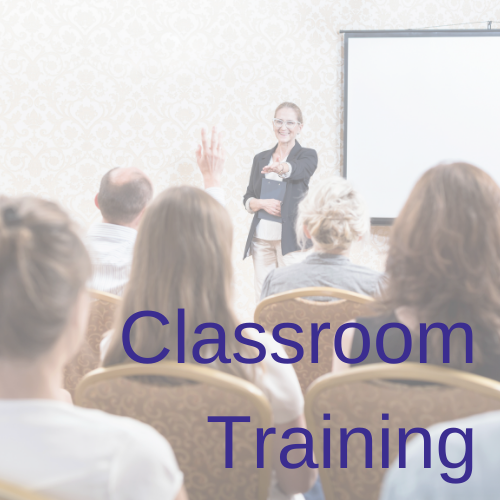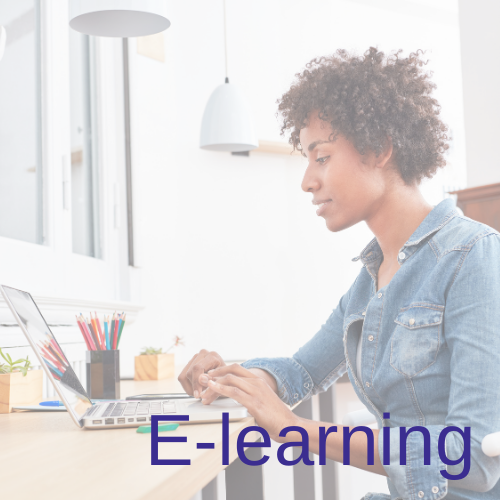At First Response Training, we are especially passionate about delivering superb First Aid training throughout the UK. Current ambulance waiting times are over 9 minutes for life-threatening emergencies; we all become safer as more members of the public become first aiders. Our First Aid courses cover a range of topics and are available as introductory courses for beginners or advanced courses for those with existing First Aid training.
With over 100 trainers in England, Scotland and Wales, we can provide in-person, practical First Aid training at your location of choice. All of our trainers are highly qualified and experienced. Many volunteer in their spare time as emergency responders, which keeps their skills sharp. Once you have chosen your courses, your account manager will be in touch and take care of all the logistics such as venues and equipment.
Delivery Methods
We have First Aid eLearning, classroom training and webinars available. Most of the courses below include some form of practical assessment, and so must take place face-to-face. However, webinar versions of these courses may be available if necessary. Both classroom and webinar courses are led by a qualified instructor. Our eLearning course can be completed in the learner's own time.
First Aid Courses
First Aid at Work
Duration: 3 days
Capacity: Up to 12 delegates
Learning Objectives:
- Describe your actions in an emergency
- Demonstrate the management of the unresponsive casualty
- Demonstrate adult resuscitation including use of the AED
- Explain the management of adult choking
- Describe how to recognise and treat bleeding and shock
- Explain the treatment of minor and major injuries
This course can be delivered via Classroom or Blended training. Please contact us to schedule training.
Duration: 2 days
Capacity: Up to 12 delegates
Learning Objectives:
- Describe your actions in an emergency
- Demonstrate the management of the unresponsive casualty
- Demonstrate adult resuscitation including use of the AED
- Explain the management of adult choking
- Describe how to recognise and treat bleeding and shock
- Explain the treatment of minor and major injuries
This course is delivered via Classroom training. Please contact us to schedule training.
Duration: 3 days
Capacity: Up to 12 delegates
Learning Objectives:
- Describe your actions in an emergency
- Demonstrate the management of the unresponsive casualty
- Demonstrate adult resuscitation including use of the AED
- Explain the management of adult choking
- Describe how to recognise and treat bleeding and shock
- Explain the treatment of minor and major injuries
- Understand the implications of the over consumption of alcohol and first aid actions
This course is delivered via Classroom training. Please contact us to schedule training.
Duration: 3 days
Capacity: Up to 12 delegates
Learning Objectives:
- Describe your actions in an emergency
- Demonstrate the management of the unresponsive casualty
- Demonstrate adult resuscitation including use of the AED
- Explain the management of adult choking
- Describe how to recognise and treat bleeding and shock
- Explain the treatment of minor and major injuries
This course is delivered via Classroom training. Please contact us to schedule training.
Emergency First Aid at Work
Duration: 7 hours
Capacity: Up to 12 delegates
Learning Objectives:
- Describe your actions in an emergency
- Demonstrate the management of the unresponsive casualty
- Demonstrate adult resuscitation including use of the AED
- Explain the management of adult choking, shock, sepsis and stroke
- Describe how deal with heart attack, wounds and bleeding
- Explain the treatment of seizures and burns
This course is delivered via Classroom training. Please contact us to schedule training.
Duration: 7 hours
Capacity: Up to 12 delegates
Learning Objectives:
- Describe your actions in an emergency
- Demonstrate the management of the unresponsive casualty
- Demonstrate adult resuscitation including use of the AED
- Explain the management of adult choking, shock, sepsis and stroke
- Describe how deal with heart attack, wounds and bleeding
- Explain the treatment of seizures and burns
- Understand the implications of the over consumption of alcohol and first aid actions
This course is delivered via Classroom training. Please contact us to schedule training.
Duration: 7 hours
Capacity: Up to 12 delegates
Learning Objectives:
- Describe your actions in an emergency
- Demonstrate the management of the unresponsive casualty
- Demonstrate adult resuscitation including use of the AED
- Explain the management of adult choking, shock, sepsis and stroke
- Describe how deal with heart attack, wounds and bleeding
- Explain the treatment of seizures and burns
- Explain the treatment for electric shock and how it links to all areas covered on the course
This course is delivered via Classroom training. Please contact us to schedule training.
Duration: 7 hours
Capacity: Up to 12 delegates
Learning Objectives:
- Describe your actions in an emergency
- Demonstrate the management of the unresponsive casualty
- Demonstrate adult resuscitation including use of the AED
- Explain the management of adult choking, shock, sepsis and stroke
- Describe how to deal with heart attack, wounds and bleeding
- Explain the treatment of seizures and burns
- Explain the management of a crush injury
- Explain the treatment of hypothermia
This course is delivered via Classroom training. Please contact us to schedule training.
Duration: 7 hours
Capacity: Up to 12 delegates
Learning Objectives:
- Describe your actions in an emergency
- Demonstrate the management of the unresponsive casualty
- Demonstrate adult resuscitation including use of the AED
- Explain the management of adult choking, shock, sepsis and stroke
- Describe how to deal with heart attack, wounds and bleeding
- Explain the treatment of seizures and burns
- Suicide awareness including ligature
This course is delivered via Classroom training. Please contact us to schedule training.
Outdoor First Aid
Duration: 8 hours
Capacity: Up to 12 delegates
Learning Objectives:
- Describe your actions in an emergency
- Demonstrate the management of the unresponsive casualty
- Demonstrate adult resuscitation including use of the AED
- Explain the management of adult choking, shock, sepsis and stroke
- Describe how deal with heart attack, wounds and bleeding
- Explain the treatment of seizures and burns
This course is delivered via Classroom training. Please contact us to schedule training.
Duration: 2 days
Capacity: Up to 12 delegates
Learning Objectives:
- Describe your actions in an emergency
- Demonstrate the management of the unresponsive casualty
- Demonstrate adult resuscitation including use of the AED
- Explain the management of adult choking
- Describe how to recognise and treat bleeding and shock
- Explain the treatment of minor and major injuries
This course is delivered via Classroom training. Please contact us to schedule training.
Paediatric First Aid
Duration: 3 hours
Capacity: Up to 12 delegates
Learning Objectives:
- Describe the role and responsibilities of a paediatric first aider
- Demonstrate the management of an unresponsive infant and child
- Demonstrate paediatric resuscitation
- Demonstrate the management of a child or infant who is choking
- Explain airway and breathing difficulties
- Provide an understanding of anaphylaxis
- Explain the treatment for burns and scalds, and wounds and bleeding
- Provide information regarding injuries to bones, muscles and joints, and also, the management of seizures in children, adults or infants
- List some other conditions associated with infants and children and their treatment
This course can be delivered via Classroom or Webinar training. Please contact us to schedule training.
Duration: 7 hours
Capacity: Up to 12 delegates
Learning Objectives:
- Describe actions in an emergency situation
- Demonstrate the management of an unresponsive adult, infant and child
- Demonstrate adult and paediatric resuscitation
- Demonstrate the management of an adult, child or infant who is choking
- Explain the treatment for hypovolaemic shock
- Demonstrate the treatment of wounds and bleeding
- Explain the treatment for burns and scalds
- Explain the management of seizures in children, adults or infants
This course is delivered via Classroom training. Please contact us to schedule training.
Duration: 2 days
Capacity: Up to 12 delegates
Learning Objectives:
- Describe the role and responsibilities of a paediatric first aider
- Demonstrate the management of an unresponsive infant and child
- Demonstrate paediatric resuscitation
- Demonstrate the management of a child or infant who is choking
- Explain airway and breathing difficulties
- Provide an understanding of anaphylaxis
- Explain the treatment for burns and scalds, and wounds and bleeding
- Provide information regarding injuries to bones, muscles and joints, and also, the management of seizures in children, adults or infants
- List some other conditions associated with infants and children and their treatment
This course is delivered via Classroom training. Please contact us to schedule training.
Duration: 3 days
Capacity: Up to 12 delegates
Learning Objectives:
- Describe your actions in an emergency
- Demonstrate adult, child and infant resuscitation including use of the AED
- Demonstrate the management of the unresponsive casualty
- Explain the management of adult, child and infant choking
- Describe how to recognise and treat bleeding and shock
- Explain the treatment of minor and major injuries
- Understand other conditions associated with infants and children and their treatment
This course is delivered via Classroom training. Please contact us to schedule training.
Immediate Life Support
Duration: 7 hours
Capacity: Up to 12 delegates
Learning Objectives:
- Understand common causes of cardiac arrest
- Understand means of preventing cardiac arrest
- Understand the ABCDE approach to cardiac arrest
- Demonstrate a range of airway management and ventilation techniques
- Demonstrate safe usage and knowledge of defibrillation
This course is delivered via Classroom training. Please contact us to schedule training.
Duration: 4 hours
Capacity: Up to 12 delegates
This course is delivered via Classroom training. Please contact us to schedule training.
Basic Life Support
Duration: 2 hours
Capacity: Up to 12 delegates
Learning Objectives:
- Describe your actions in an emergency
- Understand the management of the unresponsive casualty
- Demonstrate adult resuscitation including use of the AED
- Demonstrate adult choking techniques
This course can be delivered via Classroom or Webinar training. Please contact us to schedule training.
Duration: 3 hours
Capacity: Up to 12 delegates
Learning Objectives:
- Describe your actions in an emergency
- Understand the management of the unresponsive casualty
- Demonstrate adult resuscitation including use of the AED
- Demonstrate adult choking techniques
- Understand anaphylaxis by knowing triggers, symptoms and treatment
This course can be delivered via Classroom or Webinar training. Please contact us to schedule training.
Duration: 3 hours
Capacity: Up to 12 delegates
Learning Objectives:
- Describe your actions in an emergency
- Demonstrate the management of the unresponsive casualty
- Demonstrate adult resuscitation including use of the AED
- Demonstrate adult choking techniques
- Open recap questions on 1st aid subjects
This course can be delivered via Classroom or Webinar training. Please contact us to schedule training.
First Aid Awareness
Duration: 3 hours
Capacity: Up to 12 delegates
Learning Objectives:
- Describe your actions in an emergency
- Demonstrate the management of the unresponsive casualty
- Demonstrate adult resuscitation including use of the AED
- Explain the management of adult choking
- Describe how to recognise and treat bleeding and burns
- Explain the treatment of burns
This course can be delivered via Classroom or Webinar training. Please contact us to schedule training.
Learning Objectives:
- Describe your actions in an emergency
- Demonstrate adult resuscitation including use of the AED
- Explain the management of adult choking
- Demonstrate the management of the unresponsive casualty
- Describe how to recognise and treat bleeding and shock
- Explain the treatment of heart attack, seizures, burns, scalds and other injuries
This course is delivered via eLearning. Delegates can complete the training in their own time. At checkout, please provide the delegate's full name.
Special Focus
Duration: 3 hours
Capacity: Up to 12 delegates
Learning Objectives:
- To provide an awareness of some main allergies
- To explain anaphylaxis and identify the body systems that it affects
- To describe how to recognise anaphylaxis, and identify the symptoms
- To explain the causes of anaphylaxis
- To explain the first aid treatment for anaphylaxis
This course can be delivered via Classroom or Webinar training. Please contact us to schedule training.
Duration: 3 hours
Capacity: Up to 12 delegates
Learning Objectives:
- Manage an unresponsive casualty who is not breathing
- Understand how the heart works
- Perform CPR and use an AED effectively and safely
- Manage the aftermath including dealing with the post-incident procedures for the AED and managing a successful resuscitation
This course is delivered via Classroom training. Please contact us to schedule training.
Duration: 7 hours
Capacity: Up to 12 delegates
Learning Objectives:
- Describe your actions in an emergency
- Demonstrate the management of the unresponsive casualty
- Demonstrate adult resuscitation including use of the AED and Oxygen Therapy
- Explain the management of adult choking
- Describe how to recognize and treat bleeding and shock
- Explain the treatment of chest pain, airway and breathing problems, fainting and blood sugar emergencies
This course is delivered via Classroom training. Please contact us to schedule training.
For School Pupils
Duration: 7 hours
Capacity: Up to 12 delegates
Learning Objectives:
- Dealing with an emergency
- Demonstrate adult resuscitation including use of the AED
- Explain the management of adult choking
- Demonstrate the management of the unresponsive casualty
- Describe how to recognise and treat bleeding and shock
- Explain the treatment of heart attack, seizures and burns and scalds
This course is delivered via Classroom training. Please contact us to schedule training.
Duration: 3 hours
Capacity: Up to 12 delegates
Learning Objectives:
- Describe your actions in an emergency
- Demonstrate how to do a primary survey
- Demonstrate putting someone into the recovery position
This course is delivered via Classroom training. Please contact us to schedule training.
Duration: 1.5 hours
Capacity: Up to 12 delegates
Learning Objectives:
- Describe your actions in an emergency
- Demonstrate adult resuscitation including the use of the AED
- Demonstrate the management of the unresponsive casualty
This course is delivered via Classroom training. Please contact us to schedule training.
Duration: 3 hours
Capacity: Up to 12 delegates
Learning Objectives:
- Describe your actions in an emergency
- Demonstrate adult resuscitation including use of the AED
- Explain the management of adult choking
- Demonstrate the management of the unresponsive casualty
- Demonstrate how to recognise and treat bleeding and shock
- Demonstrate how to apply an arm and elevation sling
This course is delivered via Classroom training. Please contact us to schedule training.
HABC
Duration: 7 hours
Capacity: Up to 12 delegates
Learning Objectives:
- Describe your actions in an emergency
- Demonstrate the management of the unresponsive casualty
- Demonstrate adult resuscitation including use of the AED
- Explain the management of adult choking, shock, sepsis and stroke
- Describe how to deal with heart attack, wounds and bleeding
- Explain the treatment of seizures and burns
This course is delivered via Classroom training. Please contact us to schedule training.
Duration: 3 days
Capacity: Up to 12 delegates
Learning Objectives:
- Describe your actions in an emergency
- Demonstrate the management of the unresponsive casualty
- Demonstrate adult resuscitation including use of the AED
- Explain the management of adult choking
- Describe how to recognise and treat bleeding and shock
- Explain the treatment of minor and major injuries
This course is delivered via Classroom training. Please contact us to schedule training.
Duration: 2 days
Capacity: Up to 12 delegates
This course is delivered via Classroom training. Please contact us to schedule training.
CPD Points Available
We offer CPD (Continuing Professional Development) points for successful learners. Those who complete our First Aid training courses will receive a set number of CPD points, according to the number of hours taken to complete the course. These points help learners meet targets in the workplace. Please get in touch for more details.
Course Mapping
First Response Training is accredited by Advantage Accreditation. Our curriculum team are responsible for keeping the course content up-to-date and engaging learners. Courses are designed to follow guidance from various national bodies. These include the Health and Safety Executive (HSE), Resuscitation Council UK, St John Ambulance, the National Health Service (NHS), the British Heart Foundation and others. For all First Response Training First Aid courses, learners must complete an assessment before they receive their certificates. This ensures the learner has understood the material and can carry out effective First Aid if necessary.




